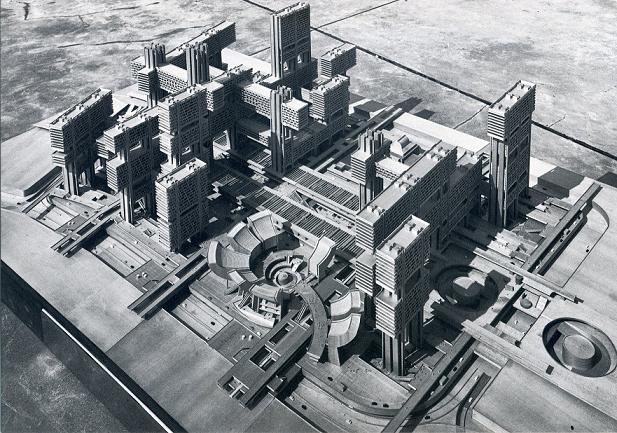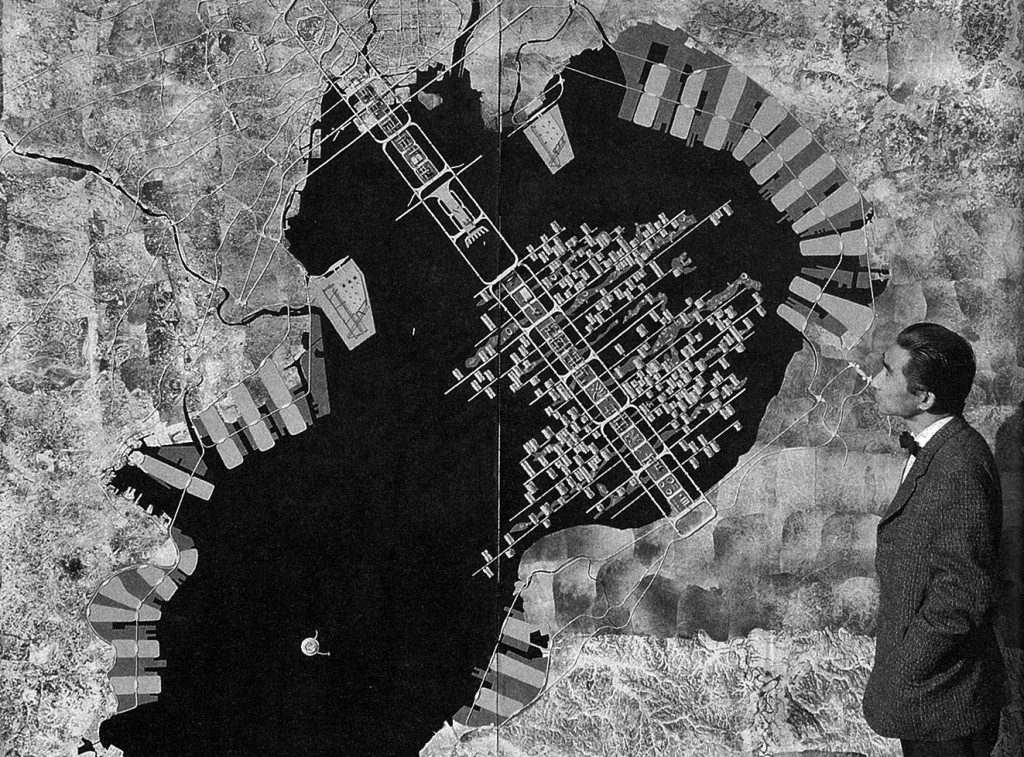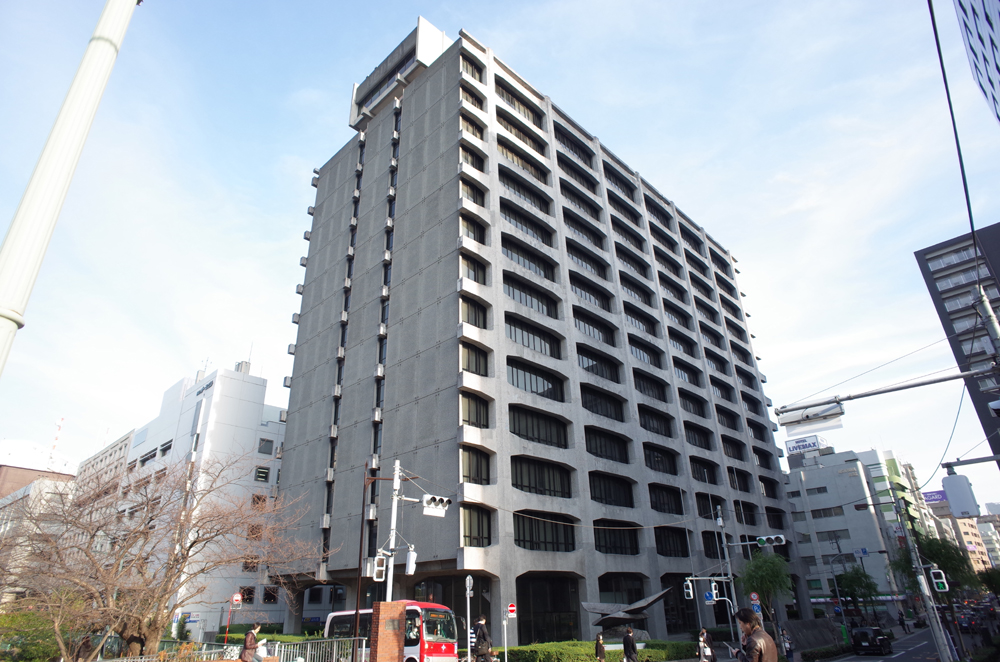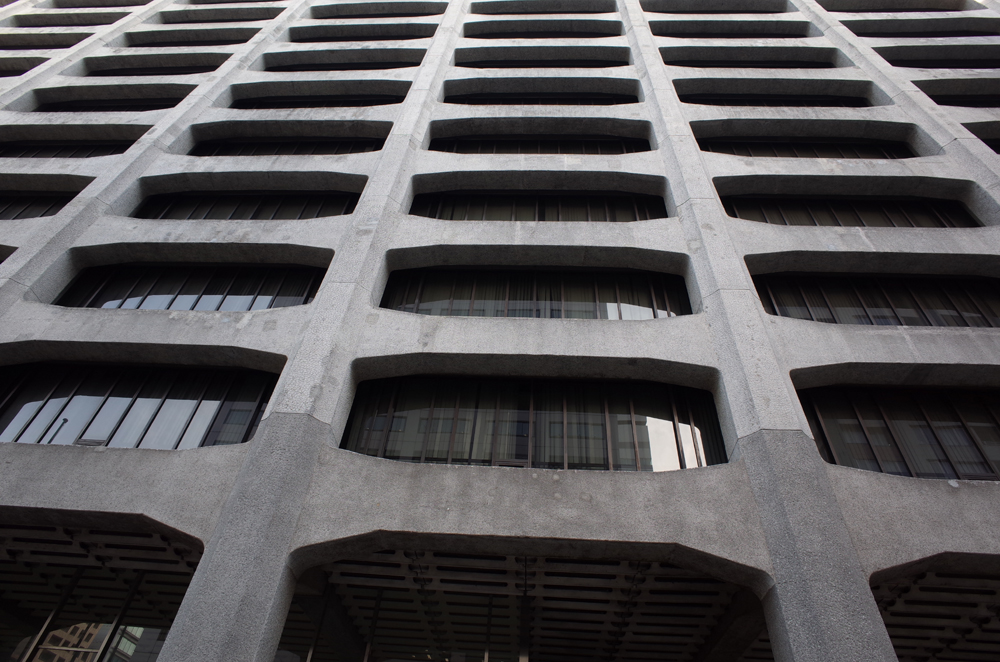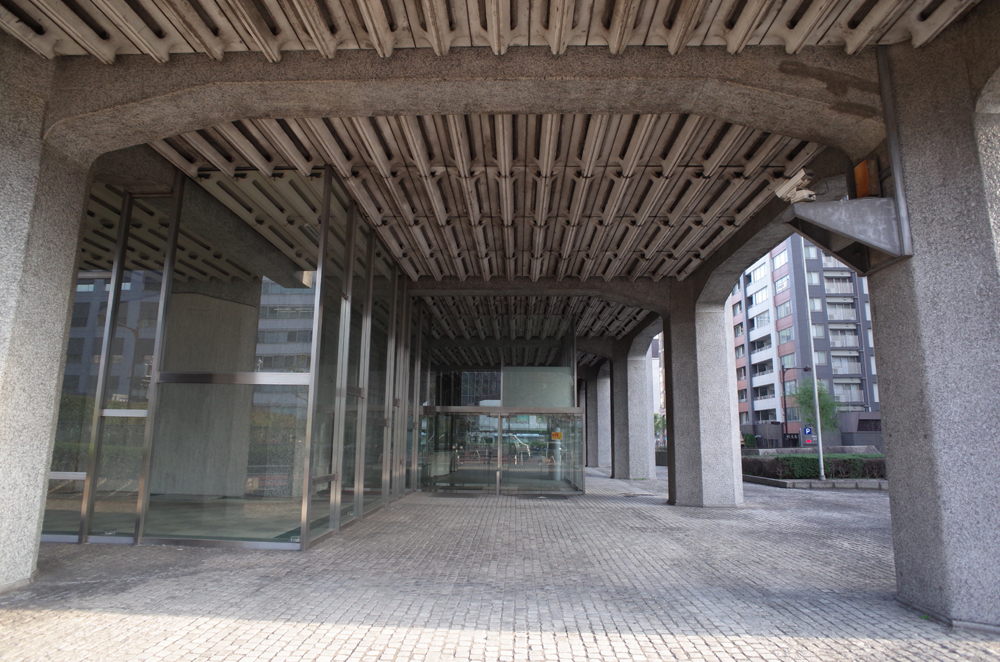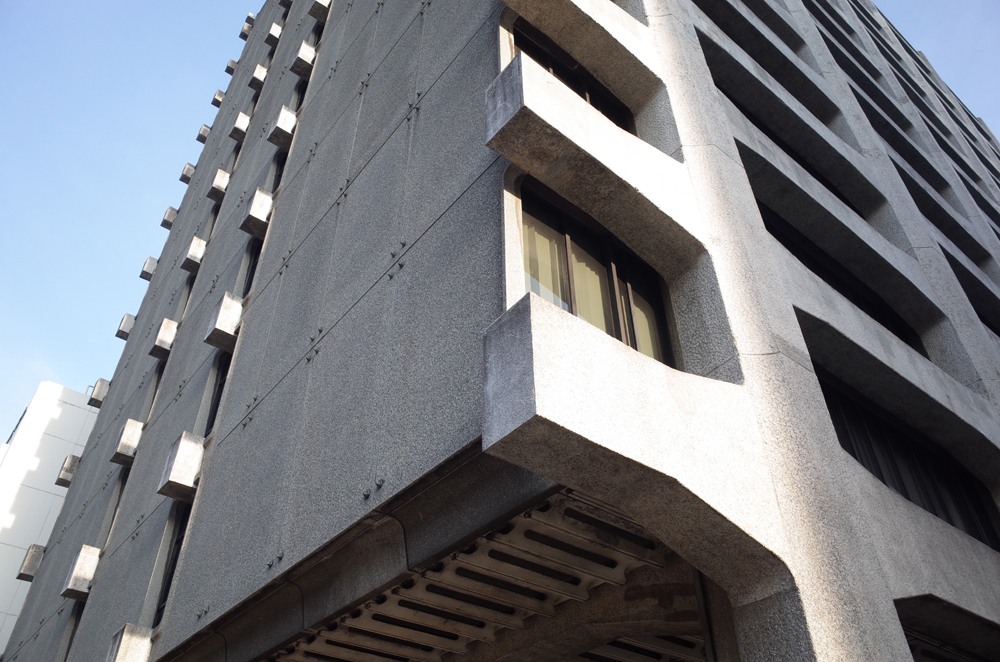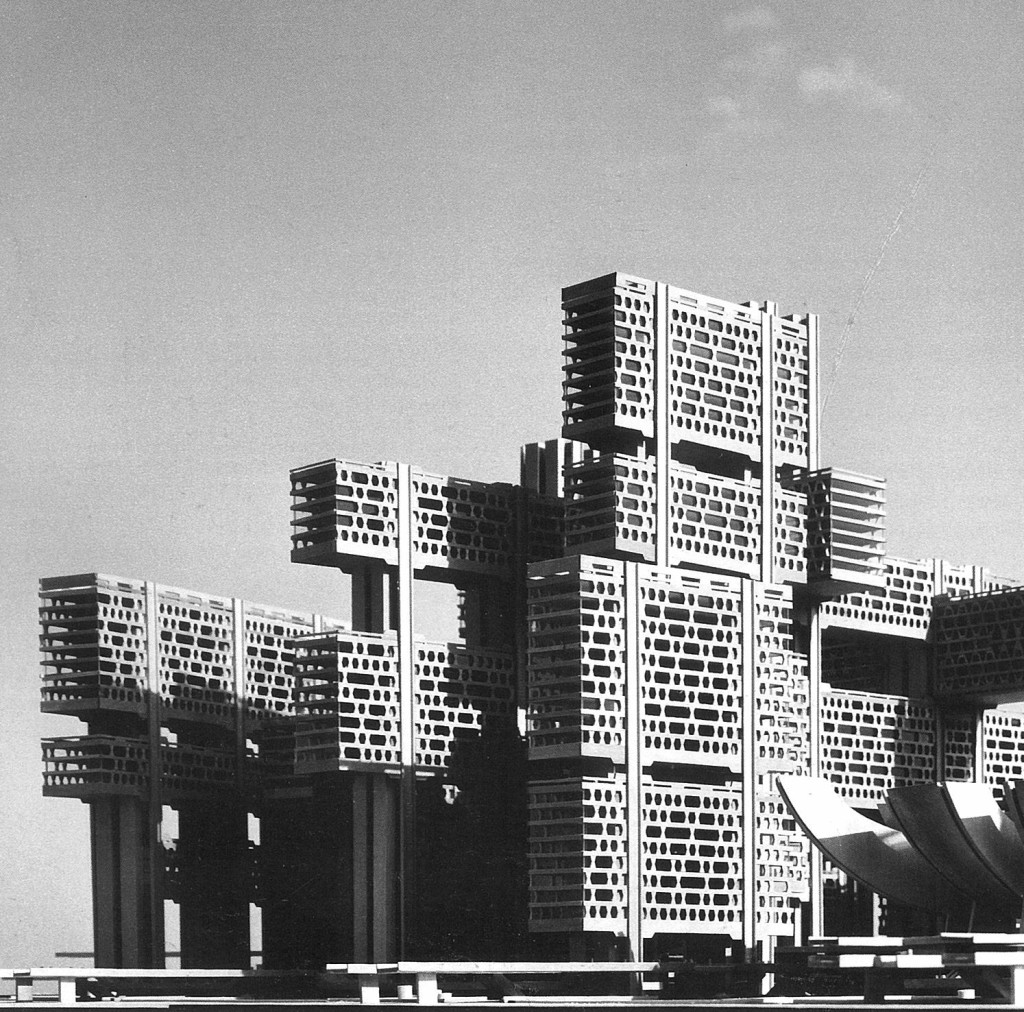Dentsu head office building of Tsukiji designed by Kenzo Tange (Ex-Dentsu Tech Building completed in 1967) will be demolished soon. Currently it is vacant house. The site will be developed by Sumitomo Real Estate together with surrounding area.
Kenzo Tange formulated the “Tsukiji redevelopment plan” (1964) for the entire Tsukiji area when asked to design a head building for Dentsu from then CEO of Dentsu Yoshida Hideo.
(* “Tsukiji redevelopment plan” CG. Tsukiji Honganji is visible in the center of the right back. From “Metabolism to the future city” by Shibaura Institute of Technology Digital Hollywood Graduate School)
The Dentsu head office building is a designed as part of entire proposal “Tsukiji redevelopment plan”. And the “Tsukiji redevelopment plan” itself was a concept as sequel to “Tokyo Project 1960” announced in 1961.
(* “Tokyo plan 1960” and Kenzo Tange “Tokyo-jin” From the November 2013 issue Photo: Akio Kawasumi)
“Tokyo Project 1960” is plan that expand the then growing Tokyo along the urban axis which linearly extends from Tokyo center to Tokyo Bay. The plan became subsequent metabolism campaign.
In “Tokyo Project 1960”, business zones are planned inside the two transport axis extending into the Tokyo bay. “Tsukiji redevelopment plan” is a concrete Tsukiji area that business zone in “Tokyo Project 1960”.
The initial design of the Dentsu head office building was a loyal representation of the “Tsukiji redevelopment plan”.
(* Initial design model of Dentsu head office building From “Kenzo Tange and TANGE KENZO” by Toyokawa Saikaku Photo: Osamu Murai)
The volumes of the two cores extend vertically. The core plays the role of structure supporting the floor, and the role of lifting workers, information and energy in vertical direction. Steel braided in the truss like a bridge is bridged between the cores, while supporting the floor, it creates cosmetic character of the outer wall. The office opened from the structure creates the pillar space, and becomes possible to in all directions including three dimensions. The core is connected to the city’s road network and facility artery via underground parking, and the piloti lifted by the core releases the building’s foot to the city.
This design plan was not realized. President Yoshida, who was a promoter of this building project, has passed away during planning stage. The design of headquater building has changed due to its significant budget overrun. The change was made from the beginning, it has the usual ramen structure by the column and beam of the current RC construction.
By making the pillars and beams outframed, although the pillar of the office space is realized as a result, the idea of the core, which was the key concept, disappeared. The lightness due to the facade of the steel truss and there is no appearance of the unfinished atmosphere reminiscent. Now the building gives massive impression.
The Dentsu headquarters building has been far from the original concepts. However it has different appeal.
The appearance covered with pillars and beams of strong presence is fresh in a sense. Existential powerfulness is there. It is something that current office building did not inherit.
Even if we turn our eyes to the detail, the ceiling of the piloti with hidden fluorescent lights, It seems to be originally designed, is can be seen as intention modernist design in the industrialization era.
The image of the original building is left casually in the side design. It insists that this building is part of a three-dimensional city that growings.
In “Tokyo Project 1960”, Kenzo Tange says that the essence of the city in the future is networking and communication. People responsible for communication are called “Organization Men”, “Organization man is lonely, but when being abandoned from this network it is even more lonely.” Surprising insight of 50 years ago.
Kenzo Tange’s two city planning did not realize. It was a project that visualized the concept of growing city by communication, network and costruction.
“Indirect communication means such as telephones, radios, televisions, cellular phones, videophones, etc. will also only trigger the demand and necessity of direct contacts. People carry messages and interact with each other. This flow is the tying band that makes organization an organization. The 10 million city is this fluid population group “(Kenzo Tange” Tokyo Project -1960 Proposal of Structural Reform “)
Le Corbusier, Tange called a master, is violently embedding the city of “green and sun and space” on the right bank of Paris, the baroque city that Osman had made, in “Voisin Plan” (1925). This image later became a prototype of the current city consisting of a car, a super block and a skyscraper as ‘shining city’.
(* “Voisin plan” model by Le Corbusier)
Then, what has happened to the city after Kenzo Tange’s whole drawing. Just ennded with one building Dentsu head office?
After 50 years now, The city drawn by Mr. Kenzo Tange’s foresight was realized in all over the world.
However, the lonely “Organization Man” sought was not communication in the real architecture, but communication in the architecture to create network space.
The model photograph of the “Tsukiji redevelopment plan” looks like a consolidated or growing server group of electronic parts housed in the casing of the computer, rather than a real building or city. Is it because Kenzo Tange’s geniusness, or just a coincidence?
So what happened to the actual city space?
With some kind of paternity and violence, even though he is not asked, he took in the site of others and without profit, draw a picture of future of this bold city. Unfortunately, there are no person like him in Japan since Kenzo Tange.
(* “Tsukiji redevelopment plan” model (part) The building on the the right is the original image of Dentsu head office building Kenzo Tange, Terunobu Fujimori “From Kenzo Tange” Photo: Osamu Murai)
* References:
Kenzo Tange, “Human and architecture”, 1970, Shokoku sha
Kenzo Tange, Terunobu Fujimori, “Kenzo Tange”, 2002, Shinkenchiku sha
“Futuristic city of metabolism” exhibition catalog, 2011
Toyokawa Saikaku, “Kenzo Tange and TANGE KENZO”, 2013, Ohm sha
“Tokyo jin” November 2013, “Kenzo Tange and Olympics”, urban publishing
text by Tetsuya Omura

